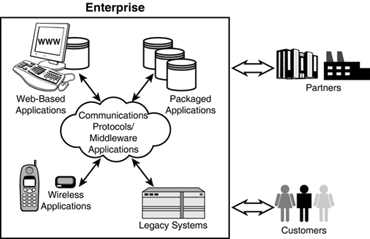Introducing Integration
| Application Integration is challenging in today's enterprises due to the complexity imposed by the use of diverse applications involving heterogeneous software and hardware environments. Enterprises in all sectors ”telecommunications, biotechnology, manufacturing, finance, and others ”have become increasingly dependent on IT and on the applications they develop, acquire, or customize. A typical enterprise has a wide spectrum of Web-based, wireless, legacy, custom-built, and canned applications operating on large amounts of information (see Figure 33.1). The information collected by these applications typically needs to be aggregated and analyzed to make strategic decisions. Many of these diverse applications, at different information points, are very specific to the line-of-business function they are designed for. Hence, it is becoming increasingly difficult to integrate them into a new application for a similar or a dependent business need, let alone integrating with existing applications such as an Enterprise Resource Planning (ERP) application or a Customer Relationship Management (CRM) application. Figure 33.1. Integration points in an enterprise. Custom "one-off" integration solutions have been used for the past two to three decades, but modern enterprises are moving away from them because they are very expensive to maintain and impossible to extend to standards-based, simplified, and extensible integration solutions when new applications are infused into the organization. WebLogic Integration (WLI) is a standards-based framework with a set of services built on top of the BEA WebLogic Server. It provides a framework for Business Process Management (BPM), Application Integration (AI) using J2EE Connector Architecture (J2CA), business-to-business (B2B), and data integration. This chapter provides a high-level introduction to the WLI product and its constituent components and products (BPM, AI framework, B2B, and data integration), which will provide context to the subsequent chapters in Part VIII, "Integration Services Provided by WebLogic Server 7." Enterprise Application Integration (EAI) projects that were typically undertaken to connect two packaged applications prove to be very resource- intensive because they typically require the use of proprietary technologies. If a company using an EAI solution tries to embrace e-business, the cost and complexity associated with integration multiply as each new Web-based system must be connected to the existing systems. |
EAN: 2147483647
Pages: 360
